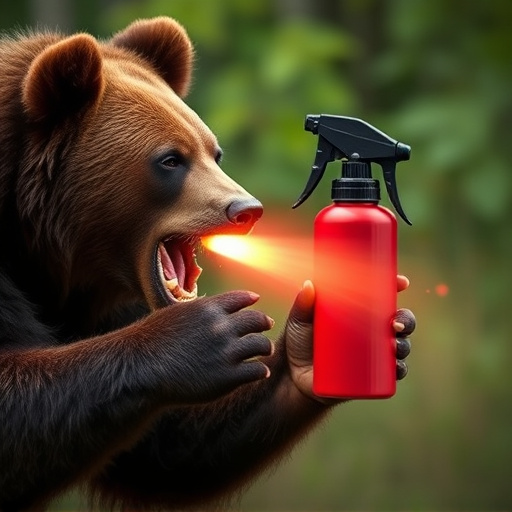Understanding bear behavior is key to preventing and managing encounters in bear country. Bears typically avoid humans unless threatened or protecting their young, and they have a powerful sense of smell that attracts them to food sources. Bear spray, when used correctly from the optimal range of 20-30 feet (6-9 meters), can deter bears as a last resort before an attack. The spray is most effective within a range of 20 to 100 feet (6 to 30 meters), but variables like wind, temperature, and bear behavior can impact its performance. Selecting the right canister size based on the expected distance of encounter is crucial for maximum effectiveness, with grizzly or black bear sprays offering protection up to 30 feet (9 meters) and longer-range options suitable for remote areas. Always read product labels and follow safety guidelines.
“In areas where bears roam, knowing how to prevent and handle attacks is crucial for outdoor enthusiasts. This article explores an essential tool in bear safety: bear attack prevention spray. We delve into understanding bear behavior and the science behind these sprays. Key topics include the optimal range for effectiveness, factors influencing performance, and how to choose the best spray for your needs, focusing on the critical ‘best distance’ for maximizing its efficacy.”
- Understanding Bear Behavior and Spray Efficacy
- What is the Optimal Range for Effective Bear Spray?
- Factors Influencing Bear Spray Performance
- Choosing the Best Bear Spray for Your Needs
Understanding Bear Behavior and Spray Efficacy
Understanding bear behavior is key to preventing and managing encounters, especially when outdoors in bear country. Bears are generally shy and avoid humans unless they feel threatened or are protecting their young. They have an excellent sense of smell and can detect food from long distances, which often leads them to campsites and picnic areas. Knowing these behaviors allows hikers and campers to take precautions, like securing food properly and making noise to deter bears.
Bear spray, also known as pepper spray, is a popular deterrent for outdoor enthusiasts in bear-inhabited regions. It’s designed to create a temporary but powerful irritation, disabling the bear’s sense of smell and vision. The recommended best distance for bear spray effectiveness ranges from 20 to 30 feet (6 to 9 meters), though this can vary depending on factors like wind, terrain, and spray concentration. Using bear spray as a last resort when an attack seems imminent can provide valuable time to escape or re-evaluate the situation.
What is the Optimal Range for Effective Bear Spray?
The optimal range for effective bear spray is a crucial consideration for anyone venturing into bear country. Studies show that the best distance for bear spray effectiveness typically ranges from 20 to 30 feet (6 to 9 meters). Beyond this range, the spray may not reach the bear’s face, which is the key area for irritation and deterrence. This distance varies based on factors like the user’s height, the wind, and the type of spray used.
To maximize effectiveness, it’s essential to aim directly at the bear’s face and eyes. The spray should create a thick cloud or mist that covers the bear from head to tail. Users should also be aware that bear spray is not a guarantee of safety; it’s one tool among many for bear attack prevention, including making noise, maintaining distance, and knowing local guidelines.
Factors Influencing Bear Spray Performance
When considering outdoor bear attack prevention spray, understanding factors influencing its performance is key to maximizing effectiveness. One of the most critical considerations is the best distance for bear spray effectiveness. Research indicates that bear spray is most potent when used at close to intermediate ranges, typically between 20 and 100 feet (6 to 30 meters). Beyond this range, the spray mist may not adequately cover the target area, reducing its impact.
Several other variables play a role in bear spray performance. Wind direction and speed can significantly affect the spray’s dispersion, potentially blowing it away from the intended target. Additionally, factors like temperature, humidity, and altitude can influence the spray’s range and intensity. Bear behavior also varies by species and individual temperament, which means what works in one situation might not be as effective in another. Therefore, users must consider these contextual elements to ensure optimal bear spray performance during outdoor activities in bear country.
Choosing the Best Bear Spray for Your Needs
When selecting a bear attack prevention spray, understanding the best distance for its effectiveness is key. The optimal range varies depending on the type of spray and the species of bear. Typically, canisters designed for grizzly bears or black bears offer protection up to 30 feet (9 meters) away. This distance ensures you can spray directly onto the bear’s face, which is a critical area for irritation and deterrence.
However, it’s important to note that factors like wind, terrain, and weather conditions can impact the spray’s range and accuracy. For more remote or rugged areas, opt for a spray with a slightly longer range, usually around 40 feet (12 meters). Always read product labels and follow safety guidelines for optimal usage, ensuring you’re prepared should you encounter a bear while hiking, camping, or exploring wilderness regions.
When it comes to outdoor safety, understanding bear behavior and choosing the right bear spray is paramount. By knowing the optimal range for effectiveness (typically around 20-30 feet, or 6-9 meters), you can ensure your protection during encounters. Several factors influence spray performance, including wind, terrain, and bearing, so selecting a high-quality bear spray tailored to your needs is crucial. Remember, proper usage techniques and regular maintenance are key to maximizing its efficacy in the event of an attack. Stay informed, stay safe, and enjoy the great outdoors responsibly.
